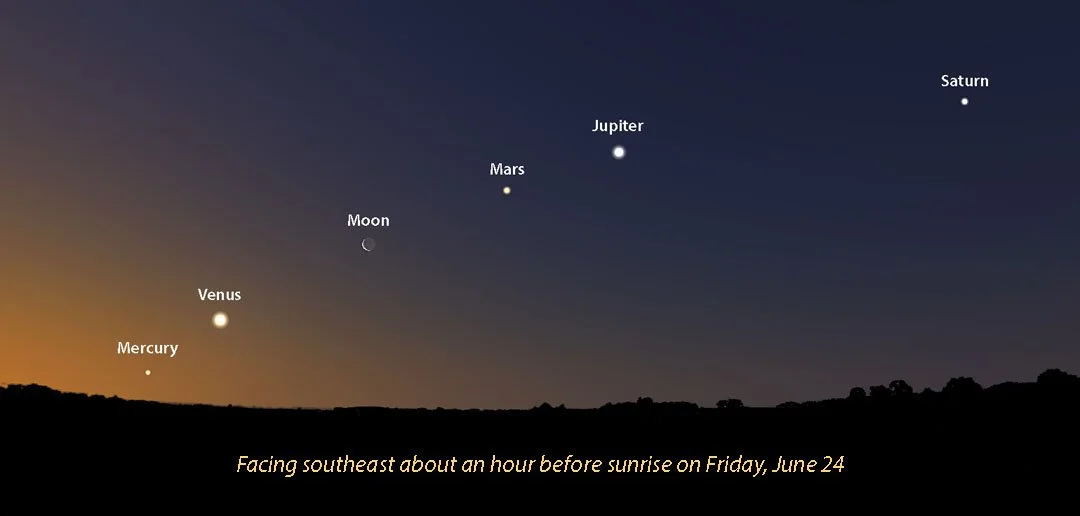June 2022 Night Sky Calendar
If you like bright planets, you’ll get to see them all this month during a rare pre-dawn alignment. I’ve listed June 24th as the prime date, but they’re also visible for several mornings before and after. Late June through early July is also the best time to look for noctilucent or “night-shining” clouds. They appear as wispy, blue-tinted streaks and ripples in the lower half of the northern sky starting about 45 minutes after sunset or before sunrise. Composed of meteor dust, noctilucent clouds hover about 50 miles high and catch sunlight long after lower clouds go dark. Dark skies aren’t necessary to view them, just a wide- open view to the north. Dusks and dawns right around June 21 are the very best times.
*Note: When “a.m.” follows the date, it refers to an event visible in the morning sky after midnight. All times are Central Daylight Time (CDT).
Noctilucent Clouds, Bob King
Events:
June 1 – See a delicate crescent moon low in the northwestern sky at dusk.
June 2 – Moon appears just 3° below Pollux (left) and Castor, the brightest stars in Gemini the Twins.
June 5 – Waxing crescent moon shines 4.5° above Regulus, brightest star in Leo the Lion.
June 7 – First Quarter Moon
June 12 – Second magnitude Delta Scorpii in Scorpius almost touches the lower right edge of the waxing gibbous moon during evening twilight. Use binoculars.
June 14 – Full Strawberry Moon
June 14-30 – Watch for noctilucent clouds starting 45 minutes to an hour after sunset.
June 18 a.m. – Waning gibbous moon swings 5.5° below Saturn at the start of morning twilight.
June 20 – Last Quarter Moon
June 21 – Summer solstice. Summer begins at 4:13 a.m. Longest day and shortest night of the year!
June 21 a.m. – Waning moon passes 4.5° to the lower right of Jupiter at the start of morning twilight low in the southeastern sky.
June 22 a.m. – Waning crescent moon slides 5° to the right of Mars low in the southeastern sky at the start of dawn.
June 24 a.m. – Grand planetary alignment! From a location where you can see the sky nearly down to the southeastern horizon, you’ll see the all five bright planets and the moon lined up at dawn starting with Saturn in the south and proceeding east to Jupiter, Mars, the waning crescent moon, Venus and Mercury. Add the Earth to make it six planets! All except Mercury are visible about 75 minutes before sunrise. Mercury appears very low about an hour before sunrise. Bring binoculars to be sure you spot it.
June 26 a.m. – Thin, waning moon snuggles near Venus, only 2° apart.
June 28 – New Moon
Grand planetary alignment / Stellarium
Bob King is an amateur astronomer, author, and passionate educator. He served as a photographer and photo editor at the Duluth News Tribune for 39 years and taught at the UMD planetarium. Bob’s work had a great impact on Voyageurs National Park. To achieve International Dark Sky Park certification, the park was required to host dark sky education events. Through the Night Sky Explorer webinars, the Conservancy was able to fulfill this component and help secure the certification for Voyageurs National Park. We can’t thank Bob King enough for sharing his talents and knowledge with the Conservancy community to support dark sky preservation.



